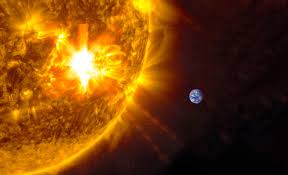
A massive solar flare has erupted from the sun. Classified as an X-class eruption, this flare has sparked concerns among scientists and officials alike. The effects could be felt globally, as the flare is expected to cause significant geomagnetic storms.
Firstly, let’s understand what an X-class flare is. These are the most powerful solar flares that can occur. They can disrupt various technologies on Earth. In this case, experts warn of potential impacts on navigation systems, power grids, and satellite communications.
As the flare reached Earth, scientists immediately began monitoring its effects. The National Oceanic and Atmospheric Administration (NOAA) reported that the flare could lead to intense geomagnetic storms. These storms occur when charged particles from the sun interact with Earth’s magnetic field. The result is often a dazzling light show in the sky, known as the aurora borealis or northern lights. However, the storms can also lead to severe disruptions.
Moreover, power grids are particularly vulnerable to these solar events. The intense energy can overload systems, leading to blackouts. Utility companies are on high alert, taking precautions to protect their infrastructure and closely monitoring the situation.
In addition to power grids, navigation systems may also face disruptions. Air travel, for example, relies heavily on satellite technology. If satellites are affected, pilots may experience navigation difficulties. Consequently, flights may be rerouted to ensure safety. Airlines are already preparing for potential delays and diversions.
Furthermore, satellite communications could suffer. The solar flare could disrupt signals and lead to communication failures. This is especially concerning for businesses that rely on satellite technology for operations. Companies are advised to have backup systems in place. Being proactive can help mitigate the risks.
In response to these developments, space weather experts are urging caution. They recommend that people stay informed about the situation, including monitoring updates from reliable sources. While the stunning visuals of auroras are a highlight, the risks are real.
In addition, there is a historical context to consider. Previous X-class flares have caused significant disruptions. For instance, the Carrington Event of 1859 is a well-known example. It caused widespread telegraph failures and created spectacular auroras as far south as the Caribbean. Experts fear that similar, albeit more advanced, disruptions could happen today.
Scientists will continue to study the flare’s impact as the situation unfolds. They are gathering data to understand better how solar activity affects Earth. This knowledge is crucial, especially as solar activity can vary greatly.
In conclusion, the massive solar flare seriously threatens our technological infrastructure. While the auroras will be breathtaking, the potential disruptions to power grids, navigation systems, and satellite communications cannot be ignored. Everyone needs to stay informed and prepared. The next few days will be critical as we watch how this solar event unfolds. Stay tuned for updates as experts work to navigate




